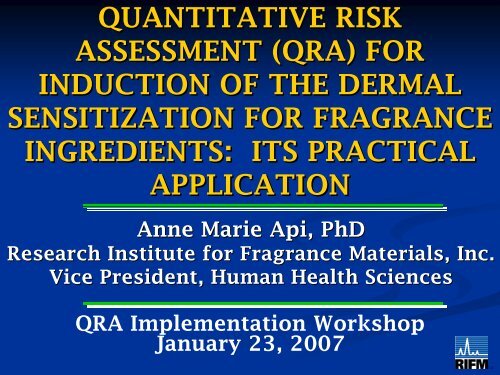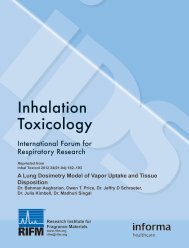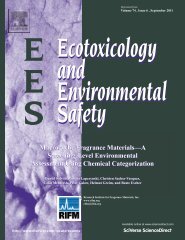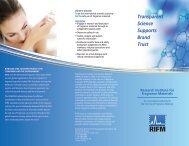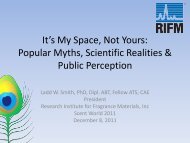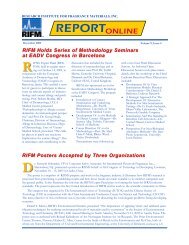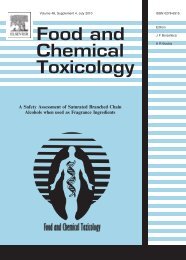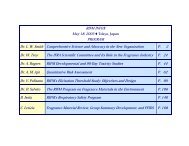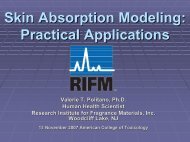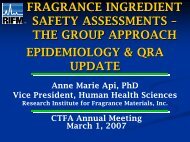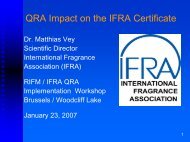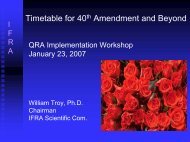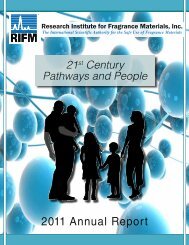Dermal Sensitization QRA Approach for Fragrance Ingredient
Dermal Sensitization QRA Approach for Fragrance Ingredient
Dermal Sensitization QRA Approach for Fragrance Ingredient
Create successful ePaper yourself
Turn your PDF publications into a flip-book with our unique Google optimized e-Paper software.
QUANTITATIVE RISK<br />
ASSESSMENT (<strong>QRA</strong>) FOR<br />
INDUCTION OF THE DERMAL<br />
SENSITIZATION FOR FRAGRANCE<br />
INGREDIENTS: ITS PRACTICAL<br />
APPLICATION<br />
Anne Marie Api, PhD<br />
Research Institute <strong>for</strong> <strong>Fragrance</strong> Materials, Inc.<br />
Vice President, Human Health Sciences<br />
<strong>QRA</strong> Implementation Workshop<br />
January 23, 2007
Contact Dermatitis, 2001, 45,<br />
333-340<br />
<strong>Dermal</strong> <strong>Sensitization</strong> Quantitative Risk Assessment (<strong>QRA</strong>)<br />
For <strong>Fragrance</strong> <strong>Ingredient</strong>s<br />
Technical Dossier<br />
March 15, 2006<br />
Revised May 26, 2006<br />
The group recommended an<br />
exposure-based <strong>QRA</strong> methodology<br />
<strong>for</strong> fragrance ingredients …now<br />
implemented<br />
Api <strong>QRA</strong> Worksop Jan 2007<br />
Revised June 22,2006<br />
<strong>QRA</strong> Expert Group<br />
Anne Marie Api (RIFM), David A. Basketter (SEAC, Unilever),<br />
Peter A. Cadby (Firmenich), Marie-France Cano (LVMH),<br />
Graham Ellis (Givaudan), G. Frank Gerberick (Procter &<br />
Gamble), Peter Griem (Clariant Produkte GmbH), Pauline M.<br />
McNamee (Procter & Gamble), Cindy A. Ryan (Procter &<br />
Gamble) and Bob Saf<strong>for</strong>d (SEAC, Unilever)
<strong>QRA</strong> IMPLEMENTATION STATUS<br />
• Technical dossier published on RIFM website<br />
www.rifm.org/pub/publications.asp<br />
• In<strong>for</strong>mational booklet issued May 2006 on RIFM<br />
website<br />
www.rifm.org/pub/publications.asp<br />
• 40 th Amendment May 2006 - Citral, Farnesol,<br />
Phenylacetaldehyde, Tea Leaf Absolute<br />
• Publications in peer reviewed journals - in<br />
preparation<br />
• Publications in trade press – in preparation<br />
• Implementation guidance - users & customers -<br />
ongoing<br />
Api <strong>QRA</strong> Worksop Jan 2007
<strong>QRA</strong> FOR DERMAL SENSITIZATION<br />
FRAGRANCE INGREDIENTS<br />
Application to induction of skin sensitization - a threshold<br />
phenomenon<br />
• Determine potential (hazard) to induce sensitization:<br />
• Pre-clinical studies e.g. Guinea-Pig Test, LLNA<br />
• Human data (historical)<br />
• Structure based predictive approach<br />
• Dose response:<br />
• Determine the No-Expected-<strong>Sensitization</strong> Induction-Level (NESIL)<br />
based on the Weight of Evidence (WoE)<br />
• Calculate <strong>Sensitization</strong> Assessment Factor (SAF)<br />
• Exposure:<br />
• Dose metric: expressed in Dose/Area<br />
• Understand consumer exposure expressed as product<br />
categories<br />
• How consumers are exposed: amount, duration and frequency<br />
• Risk characterization:<br />
Acceptable Exposure Level = WoE NESIL<br />
(AEL)<br />
(SAF)<br />
Api <strong>QRA</strong> Worksop Jan 2007
<strong>QRA</strong> FOR DERMAL SENSITIZATION<br />
FRAGRANCE INGREDIENTS: WHAT’S S NEW<br />
• NESIL - No Expected<br />
<strong>Sensitization</strong><br />
Induction<br />
Level<br />
• Establishment of scientifically sound NESILs is key<br />
• Weight of evidence approach to use of data<br />
• Identifies studies inappropriate <strong>for</strong> consideration<br />
• Can be derived from animal and human data<br />
• SAF – <strong>Sensitization</strong> Assessment Factor<br />
• Greater understanding of different elements comprising<br />
overall SAF<br />
• Extrapolation from controlled experimental situation to<br />
real life exposure scenarios<br />
• Detailed scientific rationale <strong>for</strong> SAF determination<br />
• Exposure<br />
• Consistent use of the same dose metric (μg/cm 2 )<br />
• Sources of exposure data in calculation of exposure to<br />
fragrance ingredients in consumer products<br />
Api <strong>QRA</strong> Worksop Jan 2007
CITRAL<br />
• Hazard Identification<br />
• Guinea pig data - weak sensitizer [14]<br />
• Local Lymph Node Assay<br />
• EC 3 = 1414 µg/cm 2 [11]<br />
• LOEL<br />
• HRIPT: 3876 µg/cm 2 in EtOH 5/8<br />
• HMT: 2759 µg/cm 2 in pet. 29/150<br />
• Other Data<br />
• 1240 µg/cm 2 in pet. 0/50<br />
• 775 µg/cm 2 in EtOH 0/41<br />
• 338 µg/cm 2 in EtOH 0/40<br />
• Confirmatory HRIPT - NOEL<br />
• 1400 µg/cm 2 in 3:1 DEP:EtOH 0/101<br />
Api <strong>QRA</strong> Worksop Jan 2007
EXPOSURE DATA (DOSE/AREA)<br />
Product Type<br />
Source<br />
Exposure<br />
mg/cm 2 /day<br />
Deo/AP Solid<br />
CTFA<br />
8.5<br />
Hydroalcoholic, Unshaved<br />
Women’s Facial Cream<br />
Cano & Rich*<br />
Colipa<br />
2.2<br />
0.2<br />
Shaving Cream SCCP 0.07<br />
Eye Product<br />
Body Cream<br />
Lip Products<br />
Hair Sprays<br />
Toothpaste<br />
CTFA<br />
Colipa<br />
Colipa<br />
CTFA<br />
Colipa<br />
2.17<br />
0.5<br />
11.7<br />
2.2<br />
0.13<br />
Mouthwash SCCP 1.4<br />
Shampoo<br />
Body Wash/Gels<br />
CTFA<br />
SCCP<br />
0.2<br />
0.01<br />
Api <strong>QRA</strong> Worksop Jan 2007<br />
*Cano & Rich, 2001; Tozer et al., 2004
CONSUMER EXPOSURE LEVEL<br />
Exposure assessment <strong>for</strong> shampoos:<br />
• Calculated exposure = 23,630 mg/day<br />
(CTFA)<br />
• Area = 1430 cm 2 (EPA, 1997; area hands +<br />
½ head)<br />
• Retention Factor = 1% or 0.01 (SCCNFP,<br />
2003)<br />
Exposure = 23,630 mg/day * 0.01 ÷ 1430 cm 2<br />
= 0.2 mg/cm 2 /day<br />
Api <strong>QRA</strong> Worksop Jan 2007
RISK CHARACTERIZATION FOR<br />
FRAGRANCE INGREDIENTS<br />
• Acceptable Exposure Levels (AELs) to<br />
fragrance ingredients that are dermal<br />
sensitizers can be determined in specific real<br />
life consumer product types<br />
Acceptable<br />
Exposure Level (AEL) <strong>Sensitization</strong><br />
Assessment Factor<br />
(SAF)<br />
• Comparison of Acceptable Exposure Levels<br />
(AEL) to calculated Consumer Exposure<br />
Level (CEL)<br />
Api <strong>QRA</strong> Worksop Jan 2007<br />
=<br />
WoE NESIL<br />
AEL > CEL to be Acceptable
<strong>QRA</strong> DERMAL SENSITIZATION<br />
CITRAL<br />
Weight of Evidence NESIL<br />
•Guinea-pig data – weak sensitizer<br />
•Local Lymph Node Assay<br />
EC 3<br />
= 1414 µg/cm 2 [11]<br />
•Human data<br />
HRIPT NOEL = 1400 µg/cm 2<br />
•Weight of Evidence NESIL = 1400 µg/cm 2<br />
<strong>Sensitization</strong> Assessment<br />
Factors<br />
•Considerations<br />
Inter-individual variability<br />
Product matrix differences<br />
Variations in use patterns<br />
•Hydroalcoholic Unshaved SAF is 100<br />
•Deo/AP SAF is 300<br />
Api <strong>QRA</strong> Worksop Jan 2007<br />
Exposure<br />
•Consumer exposure<br />
Hydroalcoholic (unshaved<br />
skin) = 2.2 mg/cm 2<br />
AEL = 1400/100<br />
= 14.0 µg/cm 2<br />
AEL/CEL<br />
(14.0 ug/cm 2 X 0.001<br />
mg/µg) ÷ 2.2 mg/cm 2 /day<br />
= 0.0064<br />
AEL≥CEL ≤ 0.64%<br />
•Consumer exposure<br />
DEO/AP = 8.5mg/cm 2<br />
AEL = 1400/300<br />
= 4.7 µg/cm2<br />
AEL/CEL = 0.0005<br />
AEL≥CEL ≤ 0.05%
<strong>QRA</strong> DERMAL SENSITIZATION<br />
CITRAL IN A HYDROALCOHOLIC<br />
UNSHAVED SKIN - INDUCTION<br />
0.6%<br />
13 μg/cm 2 1.7%<br />
CEL 37 μg/cm 2<br />
CEL<br />
14<br />
μg/cm 2<br />
AEL<br />
1400<br />
μg/cm 2<br />
WoE NESIL<br />
AEL/CEL Acceptable<br />
SAF = 100<br />
AEL/CEL<br />
Unacceptable<br />
0.01 0. 1 1.0 10 100 1000 10,000<br />
Citral Level - log μg/cm 2<br />
Api <strong>QRA</strong> Worksop Jan 2007
<strong>QRA</strong> DERMAL SENSITIZATION<br />
CITRAL IN SOLID AP - INDUCTION<br />
0.05%<br />
4.3 μg/cm 2<br />
CEL<br />
4.7<br />
μg/cm 2<br />
AEL<br />
1400<br />
μg/cm 2<br />
Woe NESIL<br />
AEL/CEL Acceptable<br />
SAF = 300<br />
0.01 0. 1 1.0 10 100 1000 10,000<br />
Citral Level - log μg/cm 2<br />
Api <strong>QRA</strong> Worksop Jan 2007
<strong>QRA</strong> DERMAL SENSITIZATION<br />
CINNAMIC ALDEHYDE<br />
Weight of Evidence NESIL<br />
•Guinea-pig data – moderate sensitizer<br />
•Local Lymph Node Assay<br />
EC 3 = 280 µg/cm 2 [23]<br />
•Human data<br />
HRIPT NOEL = 591 µg/cm 2<br />
•Weight of Evidence NESIL = 590 µg/cm 2<br />
SAF<br />
•Considerations<br />
Inter-individual variability<br />
Product matrix differences<br />
Variations in use patterns<br />
•Deo/AP SAF is 300<br />
•Conditioners SAF is 100<br />
Exposure<br />
•Calculation <strong>for</strong> Daily<br />
Exposure to 0.05% CA (IFRA<br />
Standard):<br />
= [Amount of CA in<br />
product x Amount product<br />
applied (mg)]/Surface area<br />
exposed (cm 2 )<br />
•Consumer exposure<br />
Deo/AP=0.05% x 8.5<br />
mg/cm 2 = 4.3 µg/cm 2<br />
Conditioners = 0.05 % x<br />
0.2 mg/cm 2 = 0.1 µg/cm 2<br />
Api <strong>QRA</strong> Worksop Jan 2007
<strong>QRA</strong> DERMAL SENSITIZATION CINNAMIC<br />
ALDEHYDE IN SOLID AP - INDUCTION<br />
2.0 μg/cm<br />
2<br />
AEL<br />
0.02%<br />
1.7 μg/cm<br />
2<br />
CEL<br />
0.05%<br />
4.3 μg/cm<br />
2<br />
CEL<br />
590 μg/cm<br />
2<br />
WoE NESIL<br />
AEL/CEL Acceptable<br />
SAF = 300<br />
AEL/CEL<br />
Unacceptable<br />
0.001 0. 01 0.1 1.0 10 100 1000<br />
Cinnamic Aldehyde Level - log μg/cm<br />
2<br />
Api <strong>QRA</strong> Worksop Jan 2007
<strong>QRA</strong> DERMAL SENSITIZATION CINNAMIC<br />
ALDEHYDE IN CONDITIONERS - INDUCTION<br />
0.05%<br />
0.1 μg/cm 2<br />
CEL<br />
3.0% =<br />
5.8 μg/cm 2<br />
Potential<br />
Consumer<br />
exposure<br />
5.9<br />
μg/cm 2<br />
AEL<br />
590 μg/cm 2<br />
WoE NESIL<br />
AEL/CEL<br />
Acceptable<br />
SAF = 100<br />
0.001 0. 01 0.1 1.0 10 100 1000<br />
Cinnamic Aldehyde Level - log μg/cm<br />
2<br />
Api <strong>QRA</strong> Worksop Jan 2007
REFINEMENT RISK ASSESSMENT-<br />
SKIN SENSITIZATION<br />
RA<br />
Risk<br />
Mgmt<br />
Clinical<br />
Reports<br />
Api <strong>QRA</strong> Worksop Jan 2007
PATCH TEST DATABASE<br />
<strong>Fragrance</strong><br />
<strong>Ingredient</strong><br />
U. HOSPITAL LEUVEN<br />
2000-2005<br />
2005<br />
Product<br />
Type<br />
Positive Patch<br />
Test Reactions<br />
Cinnamic Deodorant 2<br />
Aldehyde<br />
Aftershave 1<br />
Isoeugenol<br />
Deodorant 1<br />
Hair Dye 1<br />
Hydroalcoholic 5<br />
Citral Hydroalcoholic 6<br />
303/3323 (9.1%) Positive to <strong>Fragrance</strong> Mix; 133/303 Positive to Own<br />
Cosmetic; 66/133 fragrance-related contact allergic reactions<br />
Api <strong>QRA</strong> Worksop Jan 2007
IFRA PRODUCT CATEGORIES<br />
IFRA Category<br />
Category 1<br />
Category 2<br />
Category 3<br />
Category 4<br />
Category 5<br />
Category 6<br />
Category 7<br />
Category 8<br />
Category 9<br />
Category 10<br />
Category 11<br />
BASED ON <strong>QRA</strong><br />
Examples of Products<br />
Lip Products, Toys, Insect Repellents<br />
Deodorants/Antiperspirants<br />
Hydroalcoholic Products <strong>for</strong> Shaved Skin, Eye Products,<br />
Men’s Facial Cream & Balms, Tampons<br />
Hydroalcoholic Products <strong>for</strong> Unshaved Skin, Hair Styling<br />
Aids & Sprays, Body Creams<br />
Women’s Facial Cream/Facial Make-up, Hand Cream, Facial<br />
Masks, Wipes/Refreshing Tissue <strong>for</strong> Hands, Face, Neck, Body<br />
Mouthwash, Toothpaste<br />
Intimate Wipes, Baby Wipes<br />
Make-up Remover, Hair Styling Aids Non-Spray, Nail Care<br />
Shampoo, Rinse-Off Conditioners, Bar Soap, Feminine<br />
Hygiene Pads & Liners<br />
Detergents, Hard Surface Cleaners, Diapers<br />
All Non-Skin or incidental skin contact products<br />
Api <strong>QRA</strong> Worksop Jan 2007
IFRA PRODUCT CATEGORY 11<br />
All non-skin contact or incidental skin<br />
contact. Including:<br />
Candles<br />
Air Fresheners and Fragrancing of all types (plug-ins, solid<br />
substrate, membrane delivery, ambient, electrical, pot<br />
pourri, powders, fragrancing sachets, incense, etc.)<br />
Deodorizers/Maskers Not Intended For Skin Contact (e.g.<br />
fabric drying machine deodorizers, carpet powders)<br />
Insecticides (e.g. mosquito coil, paper, electrical, etc.)<br />
Toilet Blocks; Joss Sticks; Shoe Polishes<br />
Machine Dishwash Detergent and Deodorizers<br />
Machine Only Laundry Detergent (e.g. liquitabs)<br />
Plastic articles (excluding toys)<br />
Fuels; Paints; Cat litter; Animal Sprays<br />
Treated Textiles (e.g. starch sprays, fabric treated with<br />
fragrances after wash, deodorizers <strong>for</strong> textiles or fabrics,<br />
tights with moisturizers)<br />
Odored Distilled Water (that can be added to steam irons)<br />
Floor wax<br />
Api <strong>QRA</strong> Worksop Jan 2007<br />
Pragmatic<br />
Level<br />
These<br />
products<br />
result in<br />
negligible<br />
skin contact.<br />
The approach<br />
<strong>for</strong> a<br />
pragmatic<br />
concentration<br />
of fragrance<br />
ingredient in<br />
this category<br />
is explained<br />
in IFRA RIFM<br />
Booklet
IFRA PRODUCT CATEGORY 5<br />
SAF<br />
Product Type<br />
Consumer<br />
Exposure<br />
Level<br />
mg/cm 2 /day<br />
100 Facial Cream/Make-up 3.17<br />
100 Hand Cream 4.2<br />
IFRA<br />
Category 5<br />
Consumer<br />
Exposure<br />
4.2<br />
Api <strong>QRA</strong> Worksop Jan 2007
IFRA PRODUCT CATEGORIES<br />
BASED ON <strong>QRA</strong><br />
IFRA<br />
Category<br />
SAF<br />
Category Consumer Exposure<br />
mg/cm 2 /day<br />
Product Type Designating<br />
IFRA Category<br />
Category 1<br />
Category 2<br />
Category 3<br />
Category 4<br />
300 11.7 Lipstick<br />
300 8.5 Solid Antiperspirant<br />
300 2.2 Aftershave<br />
100 2.2 Perfume<br />
Category 5<br />
Category 6<br />
Category 7<br />
Category 8<br />
Category 9<br />
Category 10<br />
Category 11<br />
100<br />
100<br />
300<br />
100<br />
100<br />
100<br />
10<br />
4.2<br />
1.4<br />
4.4<br />
1.0<br />
0.2<br />
0.1<br />
0.00033<br />
Hand Cream<br />
Toothpaste<br />
Intimate Wipes<br />
Hair Styling Aids<br />
Conditioners, Rinse-Off<br />
Hard Surface Cleaners<br />
Candles<br />
Api <strong>QRA</strong> Worksop Jan 2007
IFRA STANDARD LIMITS FOR<br />
CITRAL BASED ON <strong>QRA</strong><br />
IFRA<br />
Cat.<br />
Examples of Product Type<br />
Citral<br />
<strong>QRA</strong><br />
1 Lip Products 0.04%<br />
2 Deodorant/Antiperspirant 0.05%<br />
3 Hydroalc., Shaved Skin 0.2%<br />
4 Hydroalc., Unshaved Skin 0.6%<br />
5 Women Facial Cream 0.3%<br />
6 Mouthwash 1.0%<br />
7 Intimate Wipes 0.1%<br />
8 Hair Styling Aids Non-Spray 1.4%<br />
9 Conditioners, Rinse-off 5.0%<br />
10 Hard Surface Cleaners 2.5%<br />
11 Candle (Non-Skin/Incidental Skin) Limited<br />
Api <strong>QRA</strong> Worksop Jan 2007
<strong>QRA</strong> IMPLEMENTATION<br />
FUTURE FOCUS<br />
• 42 nd Amendment (2007) – about 40<br />
fragrance ingredients (new and existing)<br />
based on volume of use<br />
• 43 rd Amendment (2008) about 40<br />
fragrance ingredients (new and existing)<br />
• Key goal: to review by 2011 all chemically<br />
defined fragrance ingredients that have<br />
structural alerts <strong>for</strong> dermal sensitization<br />
that are used at greater than 1 metric ton<br />
per year on a worldwide basis.<br />
• Compliance with IFRA Standards (REXPAN(<br />
REXPAN)<br />
Api <strong>QRA</strong> Worksop Jan 2007
FUTURE <strong>QRA</strong> MEETINGS<br />
• Developments in Exposure-Based<br />
Quantitative Risk Assessment (<strong>QRA</strong>) <strong>for</strong><br />
Induction of <strong>Dermal</strong> <strong>Sensitization</strong> <strong>for</strong><br />
<strong>Fragrance</strong> <strong>Ingredient</strong>s Symposium-<br />
Wednesday March 28, 2007 1:30 PM.<br />
The Society of Toxicology Meeting,<br />
Charlotte, North Carolina, USA, March<br />
25-29, 2007.<br />
• 9 th Contact Dermatitis State-of-the-Art<br />
Issues, <strong>Fragrance</strong> Mini-Symposium<br />
Friday July 13, 2007, July 12-14, 2007,<br />
Hershey PA<br />
Api <strong>QRA</strong> Worksop Jan 2007


